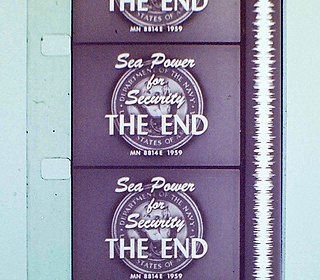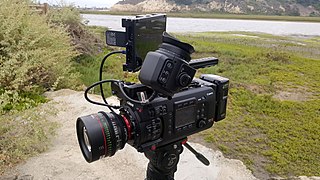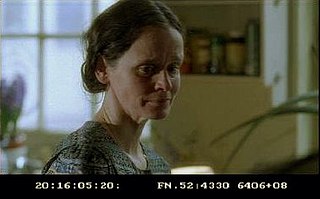Related Research Articles

Digital cinema refers to the adoption of digital technology within the film industry to distribute or project motion pictures as opposed to the historical use of reels of motion picture film, such as 35 mm film. Whereas film reels have to be shipped to movie theaters, a digital movie can be distributed to cinemas in a number of ways: over the Internet or dedicated satellite links, or by sending hard drives or optical discs such as Blu-ray discs.

16 mm film is a historically popular and economical gauge of film. 16 mm refers to the width of the film ; other common film gauges include 8 mm and 35 mm. It is generally used for non-theatrical film-making, or for low-budget motion pictures. It also existed as a popular amateur or home movie-making format for several decades, alongside 8 mm film and later Super 8 film. Eastman Kodak released the first 16 mm "outfit" in 1923, consisting of a camera, projector, tripod, screen and splicer, for US$335. RCA-Victor introduced a 16 mm sound movie projector in 1932, and developed an optical sound-on-film 16 mm camera, released in 1935.

A movie theater, cinema, or cinema hall, also known as a movie house, picture house, picture theater or simply theater, is a business that contains auditoria for viewing films for public entertainment. Most are commercial operations catering to the general public, who attend by purchasing tickets.

Home cinema, also called home theaters or theater rooms, are home entertainment audio-visual systems that seek to reproduce a movie theater experience and mood using consumer electronics-grade video and audio equipment that is set up in a room or backyard of a private home. Some studies show that films are rated better and generate more intense emotions when watched in a movie theater, but convenience is a major appeal for home cinemas. In the 1980s, home cinemas typically consisted of a movie pre-recorded on a LaserDisc or VHS tape; a LaserDisc Player or VCR; and a heavy, bulky large-screen cathode ray tube TV set, although sometimes CRT projectors were used instead. In the 2000s, technological innovations in sound systems, video player equipment and TV screens and video projectors have changed the equipment used in home cinema set-ups and enabled home users to experience a higher-resolution screen image, improved sound quality and components that offer users more options. The development of Internet-based subscription services means that 2020s-era home theatre users do not have to commute to a video rental store as was common in the 1980s and 1990s.

A movie camera is a type of photographic camera that rapidly takes a sequence of photographs, either onto film stock or an image sensor, in order to produce a moving image to display on a screen. In contrast to the still camera, which captures a single image at a time, the movie camera takes a series of images by way of an intermittent mechanism or by electronic means; each image is a frame of film or video. The frames are projected through a movie projector or a video projector at a specific frame rate to show the moving picture. When projected at a high enough frame rate, the persistence of vision allows the eyes and brain of the viewer to merge the separate frames into a continuous moving picture.
Copy protection, also known as content protection, copy prevention and copy restriction, describes measures to enforce copyright by preventing the reproduction of software, films, music, and other media.

A clapperboard, also known as a dumb slate, clapboard, film clapper, film slate, movie slate, or production slate, is a device used in filmmaking and video production to assist in synchronizing of picture and sound, and to designate and mark the various scenes and takes as they are filmed and audio-recorded. It is operated by the clapper loader. It is said to have been invented by Australian filmmaker F. W. Thring. Due to its ubiquity on film sets, the clapperboard is frequently featured in behind-the-scenes footage and films about filmmaking, and has become an enduring symbol of the film industry as a whole.

Vitaphone was a sound film system used for feature films and nearly 1,000 short subjects made by Warner Bros. and its sister studio First National from 1926 to 1931. Vitaphone is the last major analog sound-on-disc system and the only one that was widely used and commercially successful. The soundtrack is not printed on the film, but issued separately on phonograph records. The discs, recorded at 33+1⁄3 rpm and typically 16 inches (41 cm) in diameter, are played on a turntable physically coupled to the projector motor while the film is projected. Its frequency response is 4300 Hz. Many early talkies, such as The Jazz Singer (1927), used the Vitaphone system. The name "Vitaphone" derived from the Latin and Greek words, respectively, for "living" and "sound".

A movie projector is an opto-mechanical device for displaying motion picture film by projecting it onto a screen. Most of the optical and mechanical elements, except for the illumination and sound devices, are present in movie cameras. Modern movie projectors are specially built video projectors.

A bootleg recording is an audio or video recording of a performance not officially released by the artist or under other legal authority. Making and distributing such recordings is known as bootlegging. Recordings may be copied and traded among fans without financial exchange, but some bootleggers have sold recordings for profit, sometimes by adding professional-quality sound engineering and packaging to the raw material. Bootlegs usually consist of unreleased studio recordings, live performances or interviews without the quality control of official releases.
MPEG transport stream or simply transport stream (TS) is a standard digital container format for transmission and storage of audio, video, and Program and System Information Protocol (PSIP) data. It is used in broadcast systems such as DVB, ATSC and IPTV.

A workprint is a rough version of a motion picture, used by the film editor(s) during the editing process. Such copies generally contain original recorded sound that will later be re-dubbed, stock footage as placeholders for missing shots or special effects, and animation tests for in-production animated shots or sequences.
In filmmaking, dailies or rushes are the raw, unedited footage shot during the making of a motion picture. The term "dailies" comes from when movies were all shot on film because usually at the end of each day, the footage was developed, synced to sound, and printed on film in a batch for viewing the next day by the director, selected actors, and film crew members. After the advent of digital filmmaking, "dailies" were available instantly after the take and the review process was no longer tied to the overnight processing of film and became more asynchronous. Now some reviewing may be done at the shoot, even on location, and raw footage may be immediately sent electronically to anyone in the world who needs to review the takes. For example, a director can review takes from a second unit while the crew is still on location or producers can get timely updates while travelling. Dailies serve as an indication of how the filming and the actors' performances are progressing. The term was also used to describe film dailies as "the first positive prints made by the laboratory from the negative photographed on the previous day".
A cam is a bootleg recording of a film. Generally unlike the more common DVD rip or screener recording methods which involve the duplication of officially distributed media, cam versions are original clandestine recordings made in movie theaters.
Pirated movie release types are the different types of pirated movies and television series that are shared on the Internet. The quality and popularity of pirated movie release types vary widely, due to the different sources and methods used for acquiring the video content, the development and adoption of encoding formats, and differing preferences on the part of suppliers and end users as to quality and size-efficiency.
R5, in the film business, is a DVD of a movie sold in Russia very soon after the first screening in cinema, at reduced wholesale prices. It is made with a telecine machine from an analog source and is typically of a lower quality than other retail releases.
Audio-to-video synchronization refers to the relative timing of audio (sound) and video (image) parts during creation, post-production (mixing), transmission, reception and play-back processing. AV synchronization can be an issue in television, videoconferencing, or film.

In filmmaking, Foley is the reproduction of everyday sound effects that are added to films, videos, and other media in post-production to enhance audio quality. These reproduced sounds, named after sound-effects artist Jack Foley, can be anything from the swishing of clothing and footsteps to squeaky doors and breaking glass. Foley sounds are used to enhance the auditory experience of the movie. Foley can also be used to cover up unwanted sounds captured on the set of a movie during filming, such as overflying airplanes or passing traffic.
The term telecine refers both to a film-to-tape transferring machine, as well as the process by which film is transferred to tape. The telecine process is frequently used by filmmakers to transfer production footage to video, which can then be captured by various non-linear digital editing systems.

Multi-image is the now largely obsolete practice and business of using 35mm slides (diapositives) projected by single or multiple slide projectors onto one or more screens in synchronization with an audio voice-over or music track. Multi-image productions are also known as multi-image slide presentations, slide shows and diaporamas and are a specific form of multimedia or audio-visual production.
References
- ↑ afterdawn.com. "Glossary for film piracy terms". Archived from the original on 2012-02-04.
- ↑ Craig, Paul; Ron, Mark (April 2005). "Chapter 8: The Piracy Scene". In Burnett, Mark (ed.). Software Piracy Exposed - Secrets from the Dark Side Revealed. Publisher: Andrew Williams, Page Layout and Art: Patricia Lupien, Acquisitions Editor: Jaime Quigley, Copy Editor: Judy Eby, Technical Editor: Mark Burnett, Indexer: Nara Wood, Cover Designer: Michael Kavish. United States of America: Syngress Publishing. pp. 162–165. doi:10.1016/B978-193226698-6/50033-7. ISBN 1-932266-98-4.
A telesync is a film recorded on a professional camera (often a digital beta-cam). The cameras are placed on steady tripods and the films are recorded in an empty cinema from the main projection booth. The sound is often recorded straight from the mixing board, giving the telesync a high-quality sound. Some releases even include surround sound in Audio Compression 3 (AC3) format. Telesyncs are the most common of early releases, often being the first release a movie site accepts. Telesync movies are easier to watch than their CAM counterparts, although the picture quality is usually slightly washed out and the contrast is often out of balance. Telesyncs are commonly traded on movie sites. They are the lowest quality allowed, but are still popular with many file traders.
- ↑ Krömer, Jan; Sen, Evrim (2007) [2006]. "Chapter 3: All You Can Eat". No copy: die Welt der digitalen Raubkopie [No copy: the world of digital piracy] (in German). Germany: Tropical Publisher. pp. 110–111. ISBN 978-3-932170-82-9. Archived from the original on 2016-04-02.
- ↑ Kwok, Sai Ho (2004). "File sharing activities over BT Networks". Computers in Entertainment. 2 (2): 11. doi:10.1145/1008213.1008232. ISSN 1544-3574. S2CID 26051004.
Pirated movies exist even before their official release since the Telesync (TS) version of movies shot in the cinema can be easily produced.
- ↑ "What does "LD" and "MD" mean?". 2013-01-28.
- ↑ Fwiptv